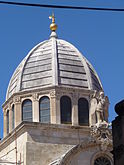Šibenik
| Šibenik | ||||||
|---|---|---|---|---|---|---|
| City | ||||||
Top: View of the city; Center left: Narrow streets of Šibenik; Center right: Cathedral dome; Bottom: Summer stage inside Šibenik Fortress
|
||||||
|
||||||
| Location of Šibenik within Croatia | ||||||
| Coordinates: 43°44′N 15°55′E / 43.733°N 15.917°E | ||||||
| Country |
|
|||||
| County |
|
|||||
| Government | ||||||
| • Mayor | Željko Burić (HDZ) | |||||
| Elevation | 0 m (0 ft) | |||||
| Population (2011) | ||||||
| • City | 46,332 | |||||
| • Urban | 58,702 | |||||
| Time zone | CET (UTC+1) | |||||
| • Summer (DST) | CEST (UTC+2) | |||||
| Postal code | 22000 | |||||
| Area code(s) | 022 | |||||
| License plate | ŠI | |||||
| Climate | Cfa | |||||
| Website | http://www.sibenik.hr/ | |||||
Šibenik (Croatian pronunciation: [ʃîbeniːk]; Italian: Sebenico) is a historic city in Croatia, located in central Dalmatia where the river Krka flows into the Adriatic Sea. Šibenik is a political, educational, transport, industrial and tourist center of Šibenik–Knin County and also the 3rd largest city in the historic region of Dalmatia. It is the oldest native Croatian town on the shores of the sea.
Unlike other cities along the Adriatic coast, which were established by Greeks, Illyrians and Romans, Šibenik was founded by Croats. Excavations of the castle of Saint Michael, have since proven that the place was inhabited long before the actual arrival of the Croats. It was mentioned for the first time under its present name in 1066 in a Charter of the Croatian King Petar Krešimir IV and, for a period of time, it was a seat of this Croatian King. For that reason, Šibenik is also called "Krešimirov grad" (Krešimir's city).
Between the 11th and 12th centuries, Šibenik was tossed back and forth among Venice, Byzantium, and Hungary. It was conquered by the Republic of Venice in 1116, who held it until 1124, when they briefly lost it to the Byzantine Empire, and then held it again until 1133 when it was retaken by the Kingdom of Hungary. It would change hands among the aforementioned states several more times until 1180.
The city was given the status of a town in 1167 from Stephen III of Hungary. It received its own diocese in 1298.
...
Wikipedia






